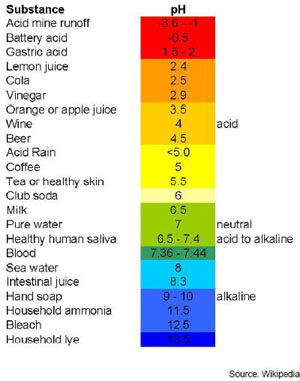Is Your Blood pH Level Keeping You In Pain?
Remember the litmus test from high school chemistry lab? You stuck a small strip of litmus paper into a solution, and if it turned red, it meant the solution was acidic. If it turned blue, the solution was basic (alkaline).

Well, the body has its own sort of litmus test: It’s called your pH level. And many health care professionals consider a balanced pH level to be the key to good health.
The term pH stands for Potential Hydrogen, which is the concentration of hydrogen ions in a substance or solution. The pH range is 0 to 14. Human blood pH is ideally 7.35. Higher numbers indicate alkalinity; lower numbers indicate acidity.
Constricted muscles
 The body simply cannot tolerate extended acid imbalances. In the early stages of an imbalance, symptoms may include such things as skin eruptions, headaches, allergies, colds and flu, and sinus problems. As things get further out of kilter, weakened systems start to give way. If tissue pH deviates too far to the acid side, oxygen levels decrease and cells die.
The body simply cannot tolerate extended acid imbalances. In the early stages of an imbalance, symptoms may include such things as skin eruptions, headaches, allergies, colds and flu, and sinus problems. As things get further out of kilter, weakened systems start to give way. If tissue pH deviates too far to the acid side, oxygen levels decrease and cells die.
On the other side of the coin, it is virtually impossible for a health disorder or disease to sustain itself when your pH is in the neutral zone (7.0-7.4). At this level, the body has a strong immunity to diseases. Most Americans, however, have a pH level of 6.2 to 6.4.
When your pH is out of the normal range, all sorts of bad things happen. For one thing, disease-producing organisms thrive. This explains why some people exposed to certain bacteria or viruses get sick while others don’t.
Acidic conditions can cause muscles to constrict and inhibit the exchange of nutrients and waste products in muscle cells, causing fatigue, soreness, and pain. In fact, a pH imbalance affects all cellular activity in the body and can lead to a wide range of degenerative diseases and symptoms.
Among other things, acidic blood blocks vitamin absorption, creates toxic buildup in clogged cells, slows organ function, prevents proper digestion, creates excess gas and bloating, causes unhealthy weight gain, and speeds the aging process.
When pH is lower than 7.0, aging is accelerated because natural acid salts build up in the walls of your cells, causing them to stiffen and dry up. By the same token, aging is slowed when acid waste is removed from the body.
How it happens
Diet and stressful lifestyle can directly affect the pH levels of all body fluids, which determines how well your immune system functions. A weakened immune system, of course, means low resistance to infections. High acid also allows LDL-cholesterol (the bad cholesterol) to build up faster in your arteries, damaging artery walls and creating plaque buildup.
High acidity enters your body when you eat processed foods, pre-packaged foods, sugary foods, pastas, dairy products (milk, cheese, ice cream, etc.), alcoholic beverages, drugs, table salt. Meats also promote acidity.
Stress plays a significant role in creating excess acid. This is why Type A personalities – who tend to live in a perpetual state of tension and rigidity – are prone to develop acidic conditions. If you don’t get enough sleep or exercise or face life-changing events – loss of a job, divorce, moving to a new city, etc. – your body probably has more acid than it can handle.
Restoring the balance
Moderate changes in your diet can help restore your pH balance. For starters, try eating more fresh fruits and vegetables, almonds, and yogurt. And go lighter on cheeses, soft drinks, alcohol, processed foods, and sweeteners (use raw honey instead). Roughly 75 percent of your diet should consist of alkaline-producing foods.
If these dietary changes seem too oppressive, you might consider taking alkaline supplements. One recent study looked at whether supplementation with alkaline minerals would influence symptoms in patients with chronic low back pain. Researchers gave 82 such patients 30 grams of a lactose-based alkaline mineral supplement (Basica) daily over a period of four weeks in addition to their medication.
Pain symptoms were measured using the Arbus Low Back Pain Rating Scale. Average pain scores significantly dropped by 49 percent, total blood buffering capacity was significantly improved, and blood pH increased. The conclusion: an unbalanced pH level may contribute to the symptoms of low back pain.
To lower your stress level, which will help put your pH reading in the normal range, you may want to try deep-breathing exercises and eating alkaline foods or what ever type of relaxation technique works for you. Moderate exercise – even walking 10 minutes a day – can also go a long way toward reducing stress and restoring balance, the key to good health.
“Reduce Pain and Improve Your Health By Addressing Your Blood PH…”
 Leading research institutions and medical journals agree that balancing your pH can help put an end to heart problems… joint pain… high blood pressure… uncontrollable cholesterol… sexual problems… blood sugar problems… fatigue and sleep problems… and much more…
Leading research institutions and medical journals agree that balancing your pH can help put an end to heart problems… joint pain… high blood pressure… uncontrollable cholesterol… sexual problems… blood sugar problems… fatigue and sleep problems… and much more…
So if you’re in constant pain and prescription drugs no longer help, don’t wait another second. Click here to learn more about Ultimate PH…
Updated: May 13,2011
